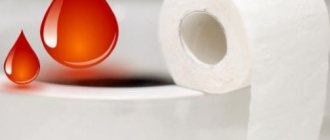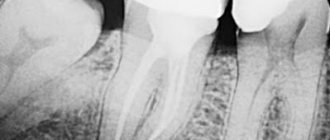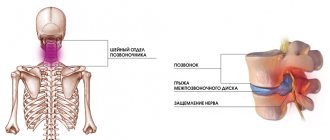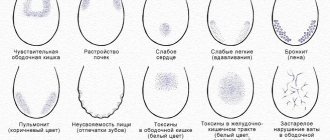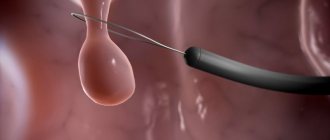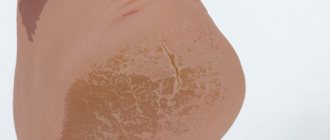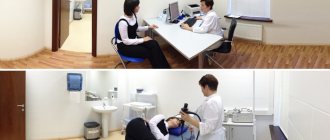What are hemorrhoids and anal fissure
Hemorrhoids are varicose veins of the hemorrhoidal plexuses located under the mucous membrane of the rectum. The localization of nodes can be internal or external, depending on which vessels have undergone changes. Anal fissure is a common companion to hemorrhoids. Occurs on the mucous membrane of the rectum, mainly on the back of the anal sphincter.
Symptoms of the disease include acute pain during defecation, bleeding, itching and burning in the rectum (at the initial stage - after defecation, at stages 3-4 - at any time, including at rest).
An anal fissure is characterized by pain in the anus after defecation, which can persist for a long time - from a few minutes to 12 hours or longer. In addition, anal fissure is characterized by scanty bleeding during bowel movements and small traces of blood on toilet paper. Severe bleeding is extremely rare.
Externally, internal hemorrhoids look like protrusions of a red or bright pink color, external hemorrhoids look like round, elastic-soft formations near the anus, which become bluish in color when thrombosis occurs. An anal fissure is a rupture of the mucous membrane of the anal canal, in most cases it is located along the posterior surface, the rupture of the mucous membrane has the shape of a triangle with the base outward.
Causes and consequences
The etiology of this disease is not fully understood. But it is believed that the main factors contributing to the occurrence of pathology are:
- too hard stool that injures the anal mucosa;
- a sedentary lifestyle, sedentary work and other behavioral characteristics that cause blood stagnation in the perineal area;
- haemorrhoids;
- impaired innervation of the rectum;
- constipation and diarrhea;
- parasitic diseases;
- childbirth;
- lifting weights.
An internal anal fissure requires mandatory treatment by a proctologist. Self-prescription of ointments, suppositories and other medications often turns out to be not only ineffective, but also dangerous, since an untreated disease becomes chronic. In this case, surgery may be necessary to treat it. Possible complications include increased pain, acute paraproctitis, and rectal fistula. In addition, similar symptoms may hide an oncological process.
Treatment methods for hemorrhoids and anal fissures
To eliminate the causes that caused the formation of hemorrhoids and anal fissures, an integrated approach is required. Of primary importance in this case is the normalization of nutrition and the prevention of constipation, which consists of enriching the diet with fiber, increasing the volume of fluid entering the body and improving intestinal motility. It is also recommended to start drug treatment starting from the first stage of the disease.
By taking drugs with local and systemic effects, it is possible to eliminate the causes of hemorrhoids and anal fissures, mitigate the consequences of their negative impact on the vessels and tissues of the rectum, and eliminate the symptoms of the disease.
Preparations for oral administration
Tablets for hemorrhoids and anal fissures are divided into several groups, each of which has a specific area of influence:
- drugs that strengthen vascular walls and make them less permeable - Detralex, Ginkor forte, Phlebodia 600, Venarus, Troxevasin;
- medications that stimulate mucosal regeneration - Litovit B;
- painkillers and anti-inflammatory drugs - Diclofenac, Ketoprofen, Indomethacin;
- drugs that stop bleeding (hemostatics) - Vikasol, Dicynon, Etamzilat;
- laxatives - Lactulose, Duphalac, Macrogol 4000 and others.
The main feature of drugs for oral administration is the complex restoration of processes occurring in the body and the possibility of adverse reactions. They are good for eliminating the underlying causes of the disease and relieve symptoms not very actively. Their use requires a doctor's approval.
Rectal suppositories
Rectal suppositories are topical preparations. Their use for hemorrhoids and anal fissures helps relieve symptoms of the disease, improve the condition of the hemorrhoidal plexuses, as well as reduce inflammation and accelerate tissue regeneration.
The following suppositories are considered the most popular and effective:
- Proctosan;
- Posterisan;
- Poctosedyl;
- Natalsid.
The main advantage of rectal suppositories is the absence of a systemic effect on the body. In most cases, they do not affect the condition of internal organs in any way. Another advantage of suppositories is ease of use. To improve the condition, they are used before bed once a day, rarely - twice a day.
Ointments for hemorrhoids and fissures
Using ointment for hemorrhoids and fissures is much more convenient than, for example, suppositories. In terms of the strength of their effect on the vessels and mucous membrane of the rectum and anus, they are not inferior to oral drugs, but differ from them in the absence of a systemic effect on the body.
Pharmaceutical companies produce several dozen ointments for hemorrhoids and fissures, among which the following drugs are considered the most effective:
| Name of ointment | Active ingredients | What does the ointment do? |
| Heparin ointment | Heparin | Promotes tissue regeneration, reduces pain and relieves itching, prevents the formation of blood clots or resolves them. |
| Vishnevsky ointment | Castor oil, xeroform powder, birch tar | Has an antiseptic effect, heals cracks, increases blood circulation. |
| Troxevasin | Troxerutin | It has a venotonic, venoprotective and anti-edematous effect. Relieves inflammation and prevents the formation of blood clots. |
| Hepatrombin | Heparin, prednisolone, lauromacrogol 600 | It has an anticoagulative, anti-inflammatory effect, prevents the formation of blood clots, reduces pain and itching. |
| Fleming's ointment | Extracts of witch hazel, calendula, horse chestnut, zinc oxide and menthol | It has anti-inflammatory, antiseptic, analgesic and calming effects. Reduces the permeability of vascular walls, improves microcirculation, promotes the formation of local immunity, and accelerates tissue regeneration. |
| Ichthyol ointment | Ichthyol | It has antiseptic, anti-inflammatory and antipruritic properties. |
| Ointment Relief | Phenylephrine, shark liver oil | Has anti-inflammatory, regenerating and analgesic effects. |
| Ointment Posterizan | Inactivated E. coli microorganisms | Stimulates tissue regeneration, restores vascular tone and reduces their permeability. |
| Ointment Bezornil | Synthetic musk and bezoar, zinc carbonate, amber, borneol, pearl | Has an anti-edematous and analgesic effect. Reduces itching, relieves inflammation, stops bleeding. |
| Aurobin ointment | Lidocaine, panthenol, prednisolone | Anesthetizes, reduces inflammation and itching, acts as an antiseptic, enhances tissue regeneration. |
| Proctosedyl ointment | Hydrocortisone, heparin, framycetin, benzocaine, butamben and esculoside | It has an analgesic, anti-inflammatory and antiseptic effect. Reduces the risk of blood clots. |
Any ointment for hemorrhoids and fissures is prescribed by a doctor, since the drugs listed in the table have contraindications and indications that must be taken into account when prescribing them to an individual patient.
Advantages of the method:
- no incisions and no need for dressings;
- safety and bloodlessness (no risk of infection);
- outpatient implementation (without hospitalization);
- rapid patient recovery;
- no dangerous side effects;
- low price compared to surgery.
Professional performance of the procedure ensures the proper therapeutic effect. In this case, the patient will not experience pain during the recovery period. With traditional operating methods, the wound heals within two weeks or more. Moreover, the process is painful and difficult. Therefore, if there is a choice between classical surgery and the radio wave technique, it is better to give preference to the second option.
How to properly apply ointments for hemorrhoids and fissures
In order for the medications to be beneficial, it is important to correctly apply the ointment for hemorrhoids and fissures:
- Before using the products, you must thoroughly wash the anal area with warm water and mild, unscented soap, preferably baby soap.
- Dry the skin of the perianal area with cotton or microfiber cloths (they are soft and absorb moisture well).
- Cream or ointment for hemorrhoids and anal fissures should be applied in a thin layer.
- Fatty ointments (Vishnevsky, Troxevasin, Fleming ointment) are recommended to be used in the form of applications. To do this, the ointment is applied to a cotton pad or gauze, and then applied to hemorrhoids and fissures for several hours.
- If the kit includes a tube attachment for introducing ointment into the rectum, which is practiced in the presence of internal nodes and cracks, it is necessary to first empty the intestines, and only then administer the drug. To make the procedure easier, you can lubricate the nozzle with Vaseline or any oil.
Important! You cannot use two topical medications at the same time - suppositories and ointment or two types of ointment.
Radio wave therapy
Minimally invasive treatment of anal fissures involves targeted exposure of tissue to high-frequency radio waves. The procedure is carried out using the Surgitron apparatus. Thanks to radio wave radiation, the liquid in pathologically altered cells evaporates, as a result of which they are destroyed. During such an operation, the electrode does not touch the mucous membrane, but acts without contact. The radio pulse is directed exclusively at the crack, so healthy tissue remains untouched. The blood vessels at the treatment site are sealed, which eliminates bleeding and speeds up healing (rehabilitation time is much shorter compared to how long it takes for marks to heal after surgery).
Before the procedure, the patient must cleanse the intestines with an enema. He is then placed on a couch in a comfortable position, anesthesia is administered, and then the doctor removes pathological tissue using a waveguide electrode.
Using homemade ointments
If you wish, you can make effective and efficient ointments for the anal wound yourself. To do this, you need to use the following components: aloe juice, honey and several streptocide tablets. All ingredients must be mixed thoroughly (pre-crush the tablets), and then apply the product to the inflamed area.
An ointment based on badger fat and propolis has quite good healing and anti-inflammatory properties. In this case, the mixture must be injected directly into the rectum using a cotton swab. Crushed chamomile flowers, which can be mixed with a teaspoon of honey and fish oil, also work well on cracks and sores in the anus. Applications with this mixture should be done for 7-10 days every evening after taking warm sitz baths.
Surgery
Treatment of anal fissures that formed 4 weeks ago or more is surgical. Minimally invasive excision methods are usually used. There are several methods that are used in modern proctology:
- laser excision;
- use of a radio knife - radio wave excision;
- using a traditional scalpel.
The operation is performed under spinal or intravenous anesthesia and takes no more than 20 minutes. The doctor excises scar changes and cleans the bottom of the defect from granulation tissue. This is a kind of return of the crack to the acute phase: no stitches are applied, the doctor creates all the conditions for further fusion of its edges. Healing takes about 2-3 weeks, and the specialist will give recommendations for a speedy recovery.
In some cases, a special method of excision of anal fissure is used, when part of the internal sphincter is additionally dissected - dosed sphincterotomy. This is necessary when the defect is accompanied by pronounced sphincter spasm.
Diagnosis of cracks
To identify anal fissures, the patient visits a proctologist. The doctor conducts an initial examination and finds out information about the patient’s medical history. During the examination, a medical specialist analyzes the symptoms and announces the presumed diagnosis. To distinguish a proctological disorder from Crohn's disease and other similar pathologies, you should take a blood, stool, and urine test. The formation of cracks is often confused with rectal fistulas, proctitis, syphilis and rectal tuberculosis.
Laboratory diagnostic tests and instrumental diagnostics are carried out. Among them:
- anoscopy of the rectum or examination of the rectal cavity using a special device;
- rectoscopy, in which an optical apparatus is inserted deep into the anus and soft tissues are examined;
- irrigoscopy (contrast radiography);
- ultrasound diagnostics of the rectum.
In the absence of contraindications, computed tomography or magnetic resonance imaging is performed.
Causes of cracks
The following are the main causes of cracks:
- mechanical injuries during pushing, labor, and medical procedures;
- injuries from unconventional sex;
- stagnation of feces in the body;
- entry of otherworldly objects into the anus;
- frequent straining during bowel movements;
- impaired blood supply due to impaired vascular function;
- impaired cellular epithelial maturation;
- abuse of fried foods;
- chemical lesions of soft tissues;
- neuromuscular sphincter injuries;
- inactive lifestyle;
- excessive physical activity, working in a standing position.
Vitamin deficiency and weakened immunity in the patient are also the cause.
Prevention
The development of anal fissure can be prevented by following certain preventive measures. The fundamental point in this case is the normalization of diet and lifestyle, which implies:
- refusal of alcohol, spicy food, smoking;
- physical activity (without lifting heavy weights);
- a diet with sufficient fiber content;
- periodic visits to a proctologist (especially after 40 years).
You can learn more about the symptoms and treatment of this disease by contacting the specialists of the Medical On Group - St. Petersburg clinic. Our proctologists use progressive methods of therapy that are minimally invasive and do not require hospitalization of the patient. After the examination, they will tell you how to cure the disease with minimal risks to the body.
Forms of the disease
There are acute and chronic anal fissures. In the first case, we are talking about a defect that first appeared no earlier than 4 weeks ago. In other cases, we are talking about a chronic defect, in which the edges of the crack thicken, scars and other structural changes form. This type of anal fissure is no longer subject to conservative treatment, since the changes are permanent.
Based on their location, there are front, rear, and side cracks. The first ones are located closer to the perineum, the rear ones - towards the tailbone.
